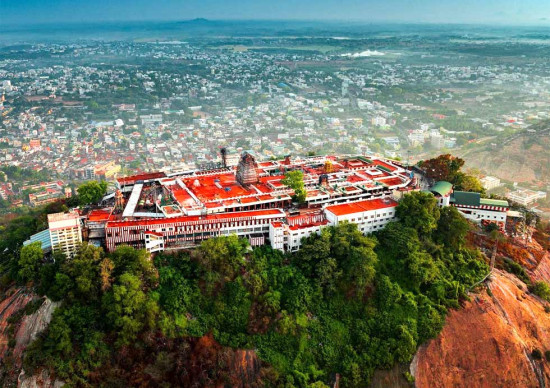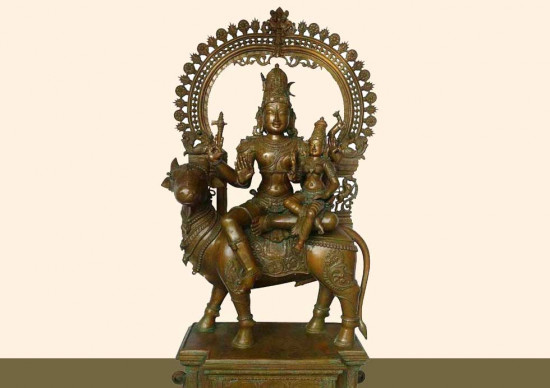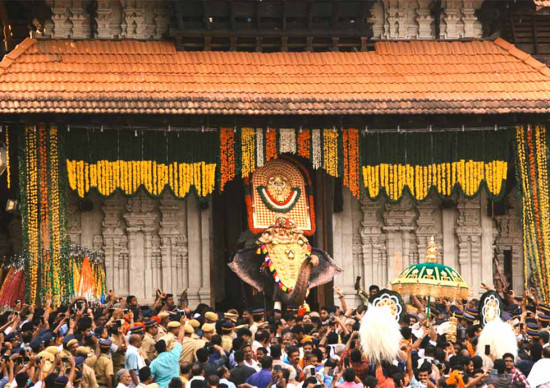
No temple of Vishnu is complete without an image of Garuda. A devotee-servant of Vishnu, Garuda is the only deity as powerful as Hanuman, another devotee-servant of Vishnu is Rama.
Not only in the Indian context but Garuda holds a significant place in the arts and iconography of Bali, Thailand, Tibet, Nepal, Mongolia, and Indonesia too.
The icon of Garuda even forms an official or national symbol for some countries. He represents aggressiveness, restless energy, and martial skills.
A short background of this deity is needed to understand his iconography.
Garuda’s story is narrated in the Mahabharata. Vinataa and Kadru were two of the many wives of sage Kashyapa, accredited as the progenitor of all species of living beings in this eon.
Vinataa – the mother of Birds, was tricked by Kadru – the mother of Serpents, into losing her independence to her in a bet, with the help of her sons (Serpents).
Garuda too, born to Vinataa after this incident, inherited his mother’s slavery to Kadru and her sons.
Wanting to buy back their freedom, Garuda bargained with the Nagas (serpents); who demanded that he bring them Amrita – the zealously guarded immortality-giving nectar of the gods.
Not only in the Indian context but Garuda holds a significant place in the arts and iconography of Bali, Thailand, Tibet, Nepal, Mongolia, and Indonesia too.
The icon of Garuda even forms an official or national symbol for some countries. He represents aggressiveness, restless energy, and martial skills.
A short background of this deity is needed to understand his iconography.
Garuda’s story is narrated in the Mahabharata. Vinataa and Kadru were two of the many wives of sage Kashyapa, accredited as the progenitor of all species of living beings in this eon.
Vinataa – the mother of Birds, was tricked by Kadru – the mother of Serpents, into losing her independence to her in a bet, with the help of her sons (Serpents).
Garuda too, born to Vinataa after this incident, inherited his mother’s slavery to Kadru and her sons.
Wanting to buy back their freedom, Garuda bargained with the Nagas (serpents); who demanded that he bring them Amrita – the zealously guarded immortality-giving nectar of the gods.

Garuda set off to Amraavati (heaven of Indra). After defeating the gods in a fight and killing the two vicious celestial snake guards he captured Amrita.
Indra, impressed, befriended Garuda and requested not to give Amrita to the undeserving Nagas. Garuda suggested Indra may stealthily reclaim Amrita as his obligation ended after delivering it. He assured Indra that he would not protect it for the Nagas.
A pleased Indra offered him a boon. Garuda requested that Nagas be decreed as his natural food so he could keep killing them without incurring sin. Indra obliged. Garuda flew on.
Garuda’s indifference to the Amrita pot in his possession impressed Vishnu immensely. He asked him why he would not consume the much sought-after Amrita himself.
Garuda argued that he would not touch Amrita, it being the price for his mother’s freedom.
Vishnu, further impressed, invited him to accept two boons. Garuda requested immortality and a place above Vishnu. Granting his requests Vishnu decreed that Garuda would never be present on the banner of his chariot, higher than him. He also blessed him with immortality.
Much delighted, Garuda respectfully invited Vishnu to ask for a boon in return.
Vishnu requested that Garuda be his eternal mount, which Garuda accepted as an honour to himself.
In light of this story, the iconography of Garuda becomes easy to understand.
He is present in all Vishnu temples on Garuda Stambha (a tall pillar, higher than the main temple) outside the main temple. This is in accordance with Vishnu’s decree in the above story, his temple being his chariot.
Garuda’s icon can also be seen on the corners of intersecting temple walls or even right outside the Garbha Griha that houses the main idol of the temple.
He is either seen kneeling or standing with his hands folded in supplication facing Vishnu. His wings upraised, waiting upon Vishnu, indicating his readiness to carry his master.
Garuda’s form is conceived as a human-bird hybrid. A beak for a nose, bird-like big round beady eyes, eagle-like claws on human hands, and a very wide span of golden-hued, powerful wings. Rest is the human body, stout and powerful.
His general countenance is that of aggressive ferocity in keeping with his status of a devoted servant who assumes his master’s protection in loving possessiveness.
Garuda’s image is shown with at-least one serpent either slithering on him or within his claws or beak indicative of his resolute serpent-devouring nature. Many times he is seen wearing serpents as ornaments like Shiva but in Garuda’s case, it only shows his excessive indulgence in killing them.
It is a wonderful sport of Vishnu that Sesha Naga – Kadru’s son and Garuda – Vinataa’s son; two sworn enemies are bound in a bond of service to him.
Indra, impressed, befriended Garuda and requested not to give Amrita to the undeserving Nagas. Garuda suggested Indra may stealthily reclaim Amrita as his obligation ended after delivering it. He assured Indra that he would not protect it for the Nagas.
A pleased Indra offered him a boon. Garuda requested that Nagas be decreed as his natural food so he could keep killing them without incurring sin. Indra obliged. Garuda flew on.
Garuda’s indifference to the Amrita pot in his possession impressed Vishnu immensely. He asked him why he would not consume the much sought-after Amrita himself.
Garuda argued that he would not touch Amrita, it being the price for his mother’s freedom.
Vishnu, further impressed, invited him to accept two boons. Garuda requested immortality and a place above Vishnu. Granting his requests Vishnu decreed that Garuda would never be present on the banner of his chariot, higher than him. He also blessed him with immortality.
Much delighted, Garuda respectfully invited Vishnu to ask for a boon in return.
Vishnu requested that Garuda be his eternal mount, which Garuda accepted as an honour to himself.
In light of this story, the iconography of Garuda becomes easy to understand.
He is present in all Vishnu temples on Garuda Stambha (a tall pillar, higher than the main temple) outside the main temple. This is in accordance with Vishnu’s decree in the above story, his temple being his chariot.
Garuda’s icon can also be seen on the corners of intersecting temple walls or even right outside the Garbha Griha that houses the main idol of the temple.
He is either seen kneeling or standing with his hands folded in supplication facing Vishnu. His wings upraised, waiting upon Vishnu, indicating his readiness to carry his master.
Garuda’s form is conceived as a human-bird hybrid. A beak for a nose, bird-like big round beady eyes, eagle-like claws on human hands, and a very wide span of golden-hued, powerful wings. Rest is the human body, stout and powerful.
His general countenance is that of aggressive ferocity in keeping with his status of a devoted servant who assumes his master’s protection in loving possessiveness.
Garuda’s image is shown with at-least one serpent either slithering on him or within his claws or beak indicative of his resolute serpent-devouring nature. Many times he is seen wearing serpents as ornaments like Shiva but in Garuda’s case, it only shows his excessive indulgence in killing them.
It is a wonderful sport of Vishnu that Sesha Naga – Kadru’s son and Garuda – Vinataa’s son; two sworn enemies are bound in a bond of service to him.







